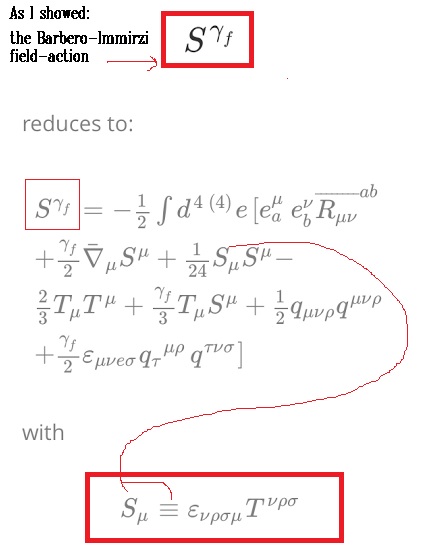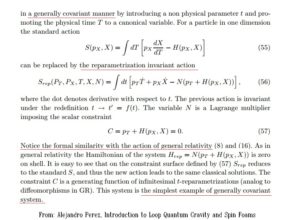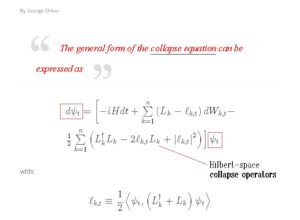I will derive the following: the Nieh–Yan action, in the context of Barbero-Immirzi Hamiltonian analysis, allows the phase-space of General Relativity to be determined by Ashtekar-Barbero variables, and as to why this is deep and crucial for the viability of LQG is a topic for another post. Recall how I showed that the Barbero–Immirzi field action:
![Rendered by QuickLaTeX.com \[\begin{array}{l}{S^{{\gamma _f}}} = - \frac{1}{2}\int {{d^4}{\,^{(4)}}} e\left[ {e_a^\mu } \right.e_b^\nu {\overline {{R_{\mu \nu }}} ^{ab}}\\ + \frac{{{\gamma _f}}}{2}{{\bar \nabla }_\mu }{S^\mu } + \frac{1}{{24}}{S_\mu }{S^\mu } - \\\frac{2}{3}{T_\mu }{T^\mu } + \frac{{{\gamma _f}}}{3}{T_\mu }{S^\mu } + \frac{1}{2}{q_{\mu \nu \rho }}{q^{\mu \nu \rho }}\\ + \frac{{{\gamma _f}}}{2}{\varepsilon _{\mu \nu e\sigma }}{q_\tau }^{\mu \rho }\left. {{q^{\tau \nu \sigma }}} \right]\end{array}\]](https://www.georgeshiber.com/wp-content/ql-cache/quicklatex.com-a0891e7cc9d6ef721f38feba43e319a9_l3.png)
with
![]()
and
![]()
the torsion-less metric-compatible covariant derivative, induces contortion spin-connections by solving:
![]()
and hence:
![]()
generalizes to:
![Rendered by QuickLaTeX.com \[\begin{array}{l}S_{NY}^{{\gamma _f}} = - \frac{1}{2}\int {{d^4}} x{\,^{(4)}}e\,e_a^\mu e_b^\nu {R_{\mu \nu }}^{ab} - \\\frac{1}{4}\int {{d^4}} x{\,^{(4)}}e{\gamma _f}\left( {{\eta _{ab}}} \right.T_{\mu \nu }^aT_{\rho \sigma }^a - \\e_a^\mu e_b^\nu \varepsilon _{cd}^{ab}\left. {{R_{\mu \nu }}^{cd}} \right)\end{array}\]](https://www.georgeshiber.com/wp-content/ql-cache/quicklatex.com-bac6613a1aed3dcb673a33761fd10bb3_l3.png)
Thus, the second integral is the Nieh-Yan topological invariant and connects to the Holst term, yielding:
![Rendered by QuickLaTeX.com \[\begin{array}{l}^\dagger S_{NY}^{{\gamma _f}} = - \frac{1}{2}\int {{d^4}} x{\,^{(4)}}e\left[ {e_a^\mu } \right.e_b^\nu {\overline {{R_{\mu \nu }}} ^{ab}}\\ + \frac{{{\gamma _f}}}{2}{{\bar \nabla }_\mu }{S^\mu } + \frac{1}{{24}}{S_\mu }{S^\mu } - \frac{1}{3}{T_\mu }{T^\mu }\\ + \frac{1}{2}{q_{\mu \nu \rho }}\left. {{q^{_{\mu \nu \rho }}}} \right]\end{array}\]](https://www.georgeshiber.com/wp-content/ql-cache/quicklatex.com-bc212042223899729c5ef767c74a794d_l3.png)
After varying the action with respect to the irreducible components of:
![Rendered by QuickLaTeX.com \[\left\{ {\begin{array}{*{20}{c}}{{S^\mu }}\\{{T^\nu }}\\{{q^{\rho \sigma \tau }}}\end{array}} \right.\]](https://www.georgeshiber.com/wp-content/ql-cache/quicklatex.com-6450fe597f88ea70d12e55209750b922_l3.png)
we obtain:
![Rendered by QuickLaTeX.com \[\left\{ {\begin{array}{*{20}{c}}{{\partial _\mu }{\gamma _f} - \frac{1}{6} - {S_\mu } = 0}\\{{T_\mu } = 0}\\{{q_{\mu \nu \rho }} = 0}\end{array}} \right.\]](https://www.georgeshiber.com/wp-content/ql-cache/quicklatex.com-96aa77603661984b8a1a282da64647ba_l3.png)
Inserting into:
![]()
one gets the effective action:
![Rendered by QuickLaTeX.com \[\begin{array}{l}S_{eff}^{{\gamma _f}} = - \frac{1}{2}\int {{d^4}} x{\,^{(4)}}ee_a^\mu e_b^\nu {\overline {{R_{\mu \iota }}} ^{ab}} + \\\frac{3}{4}\int {{d^4}} x{\,^{(4)}}e{\partial _\alpha }{\gamma _f}{\partial ^\alpha }{\gamma _f}\end{array}\]](https://www.georgeshiber.com/wp-content/ql-cache/quicklatex.com-2bb46af581f7cc76064db472a2a549b6_l3.png)
giving us an equivalence with the Hilbert-Palatini torsion-free action and thus solving the gauge-free accessibility problem as well as the 4-D uplifting problem caused by invariance under rescaling symmetry and translational symmetry.
- Now, since the phase-space has symplectic structure:
![]()
and
![]()
It thus follows that the total BI-field Hamiltonian:
![]()
with
![]()
the Lagrange multipliers, obeys:
![]()
where
![]()
is the Poisson bracket satisfying:
![Rendered by QuickLaTeX.com \[\begin{array}{l}\left\{ {E_i^a\left( x \right),A_b^i\left( x \right)} \right\} = \delta _b^a\delta _j^i\left( {x,y} \right) = \\\left\{ {\pi _i^\alpha \left( x \right),\omega _b^{(3)i}\left( y \right)} \right\}\end{array}\]](https://www.georgeshiber.com/wp-content/ql-cache/quicklatex.com-3f2a1426edc031495e3d3fb0aed0152f_l3.png)
with
![]()
being the time-evolution of the BI-field and
![]()
an arbitrary field.
Now, the Einstein field equations with the Immirzi parameter and a cosmological constant are given by the BF-type action (EIBF):
![Rendered by QuickLaTeX.com \[\begin{array}{l}S\left[ {B,\omega ,\phi ,\mu } \right] = \int_M {\left[ {\left( {{B^{IJ}} + \frac{1}{\gamma } * {B^{IJ}}} \right)} \right.} \\ \wedge {F_{IJ}}[\omega ] - {\phi _{IJKL}}{B^{IJ}} \wedge {B^{KL}} - \mu {\phi _{IJKL}}{\varepsilon ^{IJKL}}\\ + \mu \lambda + {l_1}{B_{IJ}} \wedge \left. {{B^{IJ}} + {l_2}{B_{IJ}} \wedge * {B^{IJ}}} \right]\end{array}\]](https://www.georgeshiber.com/wp-content/ql-cache/quicklatex.com-d63a87de27a7d9304ce68feb8128fa2c_l3.png)
where
![]()
is a set of 6 2-forms
![]()
and ![]() being the curvature for the connection
being the curvature for the connection ![]() with components:
with components:
![]()
with cosmological constant terms:
![]()
and ![]() the internal tensor constraining the B-field with symmetries:
the internal tensor constraining the B-field with symmetries:
![]()
![]() a 4-form and
a 4-form and ![]() is the Immirzi parameter. As is standard,
is the Immirzi parameter. As is standard, ![]() is the internal Hodge dual:
is the internal Hodge dual:
![]()
with:
![]()
Now, since one can integrate the Immirzi parameter into the theory, the following identity can be derived:
![]()
with inverse transformation:
![]()
Combining with the EIBF-action:
![Rendered by QuickLaTeX.com \[\begin{array}{l}S\left[ {B,\omega ,\phi ,\mu } \right] = \int_M {\left[ {\left( {{B^{IJ}} + \frac{1}{\gamma } * {B^{IJ}}} \right)} \right.} \\ \wedge {F_{IJ}}[\omega ] - {\phi _{IJKL}}{B^{IJ}} \wedge {B^{KL}} - \mu {\phi _{IJKL}}{\varepsilon ^{IJKL}}\\ + \mu \lambda + {l_1}{B_{IJ}} \wedge \left. {{B^{IJ}} + {l_2}{B_{IJ}} \wedge * {B^{IJ}}} \right]\end{array}\]](https://www.georgeshiber.com/wp-content/ql-cache/quicklatex.com-d63a87de27a7d9304ce68feb8128fa2c_l3.png)
one can derive the following identities:
![]()
![]()
![]()
– The first step in the Hamiltonian analysis of the EIBF-action is that, given that the total BI-field Hamiltonian:
![]()
obeys:
![]()
where
![]()
is the Poisson bracket, the Hamiltonian takes the following form:
![Rendered by QuickLaTeX.com \[\begin{array}{l}S\left[ {{\omega _a}{,^{\left( \gamma \right)}}{\Pi ^a},\tilde N,{N^a},\xi ,{\varphi _{ab}},{\psi _{ab}}} \right]\\ = \int_\mathbb{R} {dt} \int_\Omega {{d^3}} x\left( {^{\left( \gamma \right)}{\Pi ^{aIJ}}} \right.{{\dot \omega }_{aIJ}} + \tilde N\tilde H\\ + {N^a}{{\tilde H}_a} + {\xi _{IJ}}{\wp ^{IJ}} + {\varphi _{ab}}{\Phi ^{ab}} + \left. {{\psi _{ab}}{\Psi ^{ab}}} \right)\end{array}\]](https://www.georgeshiber.com/wp-content/ql-cache/quicklatex.com-99ccc2a115b989b73a6f6b21ca6e2ba2_l3.png)
with:
![]()
the canonically conjugate momenta with respect to the connection:
![]()
and the following holds:
![]()
and
![]()
is an antisymmetric tensor density of weight +1. Now, the Lagrange multipliers:
![]()
allow us to deduce the following crucial EIBF constraints:
![]()
![]()
![]()
![]()
and
![]()
and
![]()
the cosmological constant, and ![]() is the SO(1,3) covariant derivative:
is the SO(1,3) covariant derivative:
![]()
and ![]() is the determinant of the spatial metric
is the determinant of the spatial metric ![]() whose inverse
whose inverse ![]() satisfies:
satisfies:
![]()
Now, one can use the Dirac-method to eliminate some canonical variables from the theory thus reducing the solution to the equations:
![]()
![]()
to the original Holstsian phase-space. Noting that the following:
![]()
is a solution, it follows that ![]() is invertible with inverse
is invertible with inverse ![]() , and the following relation:
, and the following relation:
![]()
reduces to:
![]()
with:
![]()
Similarly, one can use
![]()
![]()
in order to collapse the symplectic structure to:
![Rendered by QuickLaTeX.com \[\begin{array}{l}\int_\Omega {{d^3}} x\left( {^{\left( \gamma \right)}{\Pi ^{aIJ}}{{\dot \omega }_{aIJ}}} \right) = \\\int_\Omega {{d^3}} x\left( {{\Pi ^{aIJ}}{{\frac{\partial }{{\partial t}}}^{\left( \gamma \right)}}{\omega _{aIJ}}} \right) = \\2\int_\Omega {{d^3}} x\left( {{E^{ai}}{{\dot A}_{ai}} + {\zeta _i}{{\dot \chi }^i}} \right)\end{array}\]](https://www.georgeshiber.com/wp-content/ql-cache/quicklatex.com-46c5dd241acad60db3a3cf294bd8d9d5_l3.png)
such that the following hold:
![]()
![]()
hence, the phase space variables:
![]()
obey the Poisson brackets:
![]()
![]()
Now, since:
![]()
is an inhomogeneous linear system of equations for the unknowns ![]() , with general solution:
, with general solution:
![]()
From:
![]()
we can derive:
![]()
thus, we have a linear map:
![]()
whose inverse map is:
![]()
together with:
![]()
Consistency conditions with the Holst action impose on us:
![Rendered by QuickLaTeX.com \[\begin{array}{l}{M^{ij}} = \frac{1}{{1 + \sigma {\chi _m}{\chi ^m}}}\left[ {\left( {{f^k}_k + \sigma {f_{kl}}{\chi ^k}{\chi ^l}} \right)} \right.{\delta ^{ij}}\\ + \left( {\sigma {f^k}_k - \sigma {f_{kl}}{\chi ^k}{\chi ^l}} \right){\chi ^i}{\chi ^j} - \\{f^{ij}} - {f^{ji}} - \sigma \left( {{f^{ik}}{\chi ^j} + {f^{jk}}{\chi ^i} + {f^{kj}}{\chi ^i}} \right)\left. {{\chi _k}} \right]\end{array}\]](https://www.georgeshiber.com/wp-content/ql-cache/quicklatex.com-4b976dc3155a7ea6cc7eb7af1c290939_l3.png)
by substituting, we can derive:
![]()
with:
![]()
Now, we are in a position to rewrite the remaining constraints in:
![Rendered by QuickLaTeX.com \[\begin{array}{l}S\left[ {{\omega _a}{,^{\left( \gamma \right)}}{\Pi ^a},\tilde N,{N^a},\xi ,{\varphi _{ab}},{\psi _{ab}}} \right]\\ = \int_\mathbb{R} {dt} \int_\Omega {{d^3}} x\left( {^{\left( \gamma \right)}{\Pi ^{aIJ}}} \right.{{\dot \omega }_{aIJ}} + \tilde N\tilde H\\ + {N^a}{{\tilde H}_a} + {\xi _{IJ}}{\wp ^{IJ}} + {\varphi _{ab}}{\Phi ^{ab}} + \left. {{\psi _{ab}}{\Psi ^{ab}}} \right)\end{array}\]](https://www.georgeshiber.com/wp-content/ql-cache/quicklatex.com-99ccc2a115b989b73a6f6b21ca6e2ba2_l3.png)
as phase-space variables, thus the Gauss constraint splits into boost and rotational parts as follows:
![Rendered by QuickLaTeX.com \[\begin{array}{l}\wp _{boost}^i: = {\wp ^{0i}} = {\partial _a}\left( {{E^{ai}} + \frac{\sigma }{\gamma }{\varepsilon ^i}_{jk}{E^{ai}}{\chi ^k}} \right)\\ + \,2\sigma {A_{aj}}{E^{a\left[ {^j{\chi ^i}} \right]}} + \sigma {\zeta _j}{\chi ^j}{\chi ^i} + {\zeta ^i}\end{array}\]](https://www.georgeshiber.com/wp-content/ql-cache/quicklatex.com-1838d3091a97cee4359d0190e1ff3ea7_l3.png)
and
![Rendered by QuickLaTeX.com \[\begin{array}{l}\wp _{rot}^i: = \frac{1}{2}{\varepsilon ^i}_{jk}{\wp ^{jk}} = {\partial _a}\left( {{\varepsilon ^i}_{jk}{E^{aj}}{\chi ^k} + \frac{1}{\gamma }{E^{aj}}} \right)\\ - {\varepsilon ^i}_{jk}\left( {A_a^j{E^{ak}} - {\zeta ^j}{\chi ^k}} \right)\end{array}\]](https://www.georgeshiber.com/wp-content/ql-cache/quicklatex.com-da5244ca12dda6e9ef7a2a78a7d5051c_l3.png)
yielding the vector and scalar constraints:
![Rendered by QuickLaTeX.com \[\begin{array}{l}{{\tilde H}_a} = 2{E^{bi}}{\partial _{\left[ {_b{A_a}} \right]i}} - {\zeta _i}{\partial _a}{\chi ^i} + \\\frac{{{\gamma ^2}}}{{{\gamma ^2} - \sigma }}\left[ {2\sigma } \right.{E^{b\left[ {^i{\chi ^j}} \right]}}{A_{ai}}{A_{bj}} - \\ - {A_{ai}}\left( {{\zeta ^i} + \sigma {\zeta _j}{\chi ^j}{\chi ^i}} \right) + \\\frac{\sigma }{\gamma }{\varepsilon _{ijk}}\left( {{E^{bi}}A_b^j + {\zeta ^i}{\chi ^j}} \right)\left. {A_a^k} \right]\end{array}\]](https://www.georgeshiber.com/wp-content/ql-cache/quicklatex.com-f5b8bfa5701f33d8608cf5e6540e5d9d_l3.png)
and
![Rendered by QuickLaTeX.com \[\begin{array}{l}\tilde H = - \sigma {E^{ai}}{\chi _i}{{\tilde H}_a} + \left( {1 + \sigma {\chi _k}{\chi ^k}} \right)\\ \cdot \left( {{E^{ai}}{\partial _a}{\zeta _i} + \frac{1}{2}{\zeta _i}{E^{ai}}{E^{bj}}{\partial _a}{E_{bj}}} \right)\\ - \frac{{\sigma {\gamma ^2}}}{{{\gamma ^2} - \sigma }}\left\{ {\left( {1 + \sigma {\chi _l}{\chi ^l}} \right)} \right.\left[ {{E^{ai}}} \right.{E^{bj}}{A_{a\left[ {\left. i \right)} \right.}}{A_{b\left[ {\left. j \right)} \right.}}\\ + {\zeta _i}{\chi ^i}{A_{aj}}{E^{aj}} + \frac{3}{4}{\left( {{\zeta _i}{\chi ^i}} \right)^2} + \frac{3}{4}\sigma {\zeta _i}{\zeta ^i}\\ - \frac{1}{\gamma }{\varepsilon _{ijk}}{E^{ai}}A_a^j\left. {{\zeta ^k}} \right] - \frac{\sigma }{4}{\left( {f_i^i} \right)^2} + \\\frac{\sigma }{2}{f^{ij}}{f_{\left( {ij} \right)}} - \frac{1}{2}{f_{ij}}{\chi ^i}{\chi ^j}\left( {f_k^k - \frac{\sigma }{2}{f_{kl}}{\chi ^k}{\chi ^l}} \right)\\ + \frac{1}{4}\left( {{f_{ij}} + {f_{ji}}} \right)\left( {{f^{ik}} + {f^{ki}}} \right)\left. {{\chi ^j}\chi k} \right\}\\ + 2\Lambda \left( {1 + \sigma {\chi _k}{\chi ^k}} \right)E\end{array}\]](https://www.georgeshiber.com/wp-content/ql-cache/quicklatex.com-67818ef8664570836ce6cd48b6e09081_l3.png)
where:
![]()
relates to ![]() via:
via:
![]()
Hence, our phase space is now determined by 12, down from 24, canonical pairs:
![]()
and to construct the Barbero’s formulation one must demand that the variables ![]() constitute a densitized triad for the spatial metric
constitute a densitized triad for the spatial metric ![]() , that is:
, that is:
![]()
Up until now, our formalism and theory is fully diffeomorphism and Lorentz invariant, however, one must break the Lorentz group ![]() down to its compact subgroup
down to its compact subgroup ![]() in order to derive the Ashtekar-Barbero variables, and this is accomplished by choosing the time-gauge:
in order to derive the Ashtekar-Barbero variables, and this is accomplished by choosing the time-gauge:
![]()
The solution of the second-class constraints is thus given by:
![]()
and:
![]()
![]()
where ![]() is the rotational part of
is the rotational part of ![]() , that is:
, that is:
![]()
which allow us to derive:
![]()
![]()
![]()
Combining them, one gets:
![Rendered by QuickLaTeX.com \[\begin{array}{l}\frac{{{\gamma ^2}}}{{{\gamma ^2} - \sigma }}\left( {\wp _{boost}^i - \frac{\sigma }{\gamma }\wp _{rot}^i} \right) = \\{\partial _a}{E^{ai}} + {\varepsilon ^{ijk}}{\Gamma _{ak}}{E^a}_j = 0\end{array}\]](https://www.georgeshiber.com/wp-content/ql-cache/quicklatex.com-5c3052810c6a92f9230611273bf862e0_l3.png)
and together with:
![]()
we get the following solution:
![]()
And here’s the crucial point: this is the spin-connection of the densitized triad 
and satisfies the following 3 relations:
![]()
![]()
![]()
with:
![]()
and:
![]()
are the curvatures of the connections:
![]()
obeying the following equations:
![]()
![]()
![]()
Hence, the reformulation of the phase space of General Relativity in terms of our canonical variables recovers the Ashtekar formulation given
our Hamiltonian:
![]()



